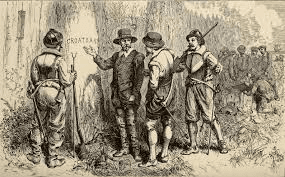
The Disappearance of the Roanoke Colony
1587 – A Bold Beginning
In the summer of 1587, 117 English settlers — men, women, and children — arrived at Roanoke Island, off the coast of present-day North Carolina, led by Governor John White.
They were tasked with establishing the first permanent English colony in the Americas, under a charter from Queen Elizabeth I.
Among them was White’s own daughter, who gave birth to Virginia Dare, the first English child born in the New World.
Supplies quickly dwindled. In need of aid, John White sailed back to England, leaving his family and the colony behind — expecting to return quickly.
He wouldn’t return for three years.
1590 – Return to Nothing
When John White finally made it back to Roanoke in August 1590, he found…
Nothing.
- The settlement was deserted
- The houses had been carefully dismantled, not burned or destroyed
- No signs of struggle, battle, or disease
- The only clue: the word “CROATOAN” carved into a tree, and “CRO” carved into another nearby post
White had left instructions that, if the colony had to move, they should carve the destination into a nearby tree. If they were in danger, they should also carve a cross.
No cross was found.
So… Who Were the Croatoan?
The Croatoan were a nearby Indigenous tribe who lived on what is now Hatteras Island, about 50 miles south.
White believed the colonists may have assimilated peacefully, but storms prevented him from ever reaching the island to verify.
He returned to England.
No rescue was ever attempted.
Theories That Refuse to Die
🏹 1. Assimilation with Native Tribes
The most accepted theory is that the settlers joined with friendly tribes, intermarried, and left Roanoke to survive.
Later reports describe European features in Native populations — but nothing conclusive.
🪓 2. Killed by Hostile Tribes
Other tribes may have viewed the colonists as invaders. But again — no bones, no ruins, no blood. Not even a mass grave.
⚓ 3. Spanish Attack
Spain still claimed parts of the Americas at the time. Could they have wiped out the colony? Unlikely — no records, and no evidence ever found.
⛏️ 4. Moved Inland and Dispersed
The colonists may have tried to move further inland to find resources or shelter, eventually being absorbed, dying out, or erased by time. But again: no records. No trail.
🕯️ 5. Something stranger
The complete lack of evidence — no diaries, no tools, no burial — fuels more eerie theories:
- Disease that caused hallucinations and madness
- Mass suicide
- A deliberate vanishing into the wilderness
- Paranormal or cosmic intervention (yep, some people seriously suggest this)
Why It Still Haunts Us
117 men, women, and children.
No graves. No remains.
No goodbye. No hello.
It’s not just the loss — it’s the emptiness. They didn’t die in fire, war, or famine. They didn’t leave signs of panic or terror.
They just… left.
And no one in history has ever heard from them again.
Legacy of the Lost
- Virginia Dare, the baby born at Roanoke, became a mythic figure in American folklore
- The word “Croatoan” has been invoked in fiction, horror, and conspiracy theories for centuries — it was even found scrawled in the journal of horror author Ambrose Bierce before he disappeared
- Roanoke became a symbol of impermanence, failure, and mystery
400+ Years Later — Still No Answer
Archaeological digs have turned up traces of English tools in Native settlements — but not enough to confirm full integration.
No bones. No graves. No final words.
Just the carved name of a tribe… and silence.